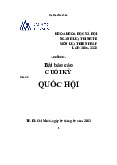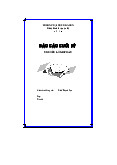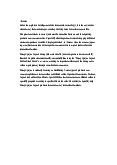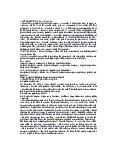















Preview text:
1. X. Corp
Twitter, a social media platform, originated in March 2006 through the collaboration of Jack
Dorsey, Noah Glass, Biz Stone, and Evan Williams. It was officially launched in July of that year.
Two years later, Jack Dorsey managed to become the company’s CEO. Twitter’s impressive
growth to 200 million users by 2012 paved the way for its IPO, a strategic move to unlock global
public funding and accelerate the platform expansion. He departed in 2009 and rejoined Twitter
in 2015. In April 2022, billionaire Elon Musk started the process of acquiring Twitter and finalized
the acquisition in October. The familiar Twitter blue bird was removed in July 2023, and replaced
by a bold “X” logo and name across the platform’s website, mobile apps, and social media
presence, marking a new era under Elon Musk’s leadership.
1.1. X Corp’s mission, values, and key stakeholders. 1.1.1. Mission Statement
Reach the largest daily audience in the world by connecting everyone to their world via our
information-sharing and distribution platform products and be one the top revenue-generating
internet companies in the world.
1.1.2. X Corp’s Vision
Elon Musk’s vision for X represents a significant difference from the core functionality of
the previously known Twitter platform. He conceptualizes X as a comprehensive, unified
application encompassing diverse functionalities such as audio and video streaming, massaging,
financial transactions, banking services, and opportunities that occur seamlessly. By integrating
these disparate functionalities, Musk seeks to fundamentally alter the paradigm of social media
interaction, dissolving the traditional boundaries between communication, commerce, and
innovation. This undertaking has the potential to reshape the digital landscape, prompting
careful consideration of its potential impact and feasibility.
1.1.3. X Corp’s Values and Principles
Promotion Health: Freedom of speech is a fundamental human right; but, the freedom to
have that speech is not increased by X Corp. Our guidelines exist to encourage healthy conversation.
People’s trust is being earned by X Corp. To be reliable and credible, we must constantly earn your trust.
Making it straightforward. Simple is excellent but straightforward is preferable. Our product,
conduct, and work habits should all be straightforward and to the point.
Uniting Profit and Purpose. Twitter is a socially responsible company. Visit X Corp for good
to learn more about how we integrate philanthropy into our business aims.
Being fast, free, and entertaining. We should move quickly, feel free to be ourselves and have fun. That is X Corp.
Twitter’s purpose, vision, and values inspire 88% of its employees. Beyond financial
compensation, a significant portion of Twitter’s workforce (12%) finds their primary job
satisfaction in fulfilling the company’s mission. This dedication extends beyond initial attraction,
as 21% cite the mission as their main reason for remaining at Twitter. Furthermore, 10% identify
the company’s mission and vision as the core of their workplace loyalty. This data aligns with
border research emphasizing the critical role of a focused mission statement and consistent core
values in fostering employee engagement and retention. 1.1.4. Key Stakeholders Internal Stakeholders
Ownership. The platform resides mainly under Elon Musk and a handful of
prominent institutional investors.
Employees. Their values, motivation, and dedication drive X Crop’s success.
Product and Engineering Teams. These individuals create and maintain the
platform’s core functionalities.
Content Creators and Users. Their active engagement generates content and drives growth. External Stakeholders
Advertisers and Marketers. Businesses leverage Twitter to reach targeted audiences and promote their offerings.
Government and Regulators. These entities ensure X Corp adheres to data privacy,
free speech, and other regulations.
Journalists and Media. Their reporting shapes public perception of the platform.
Civil Society and Advocacy Groups. These organizations were concerned about hate
speech, misinformation, and political discourse on X Corp. 1.2.
Analyze X Corp's recent successes and past crises 1.2.1. User Growth Year Users (mm) 2010 40 2011 85 2012 151 2013 218 2014 271 2015 304 2016 313 2017 310 2018 298 2019 312 2020 347 2021 362 2022 401 2023 421
Twitter’s user growth has slowed in recent years. While the platform did see steady growth
in its early years, reaching 40 million users in 2010 and 200 million in 2013, growth has
stagnated since then. In 2023, X Corp had an estimated 421 million monthly active users,
representing only a 21 million user increase from 2020. The table just shows monthly active
users, which is a different metric than total users. X Corp’s total user base may be still growing or just a bot, a fake account . 1.2.2. Product Development
Through a consistent focus on innovation, X Corp has continuously enhanced its social app
through various feature developments. This ongoing commitment to improvement strengthens X
Corp’s in the social app space using the following principles:
Customers shape the product. Don’t dedicate, adapt to user behavior. Features like
hashtags and retweets originated from users, not X Corp.
Understand user behavior. Tweetstorms and bookmarks were not invented by X
Corp. The features were built by X through listening to existing user practices.
Observe and adapt to evolving behaviors.
Test and iterate. Changing core features (character limit) can be risky. X Corp tested
cautiously, monitored user behavior, and adjusted based on data.
Customer-centric. In today’s experience economy, customers define success. Listen
to their ideas, observe their behavior, and constantly strive to improve their lives. 1.2.3. Cultural Impact
X Corp, despite its smaller user base, has demonstrably influenced various fields: Politics
Raises awareness, spreads messages, and coordinated action (#blacklivesmatter).
Gauges public opinion, though prone to biased sampling and “Twitter Storms.”
Transforms politicians into “celebrities”, potentially hindering public service focus. Science
Opens data sources and facilities for public participation (urban flood modeling).
Enables passive and active data gathering (geolocated tweet analysis) Business
Create two-way communication between businesses and customers.
Facilitates faster customer service resolution and potentially reduces costs
Provide market research opportunities and brand advocacy via loyal customers Journalism
Disrupts traditional news flow, empowering ordinary people to report events
Increases information accessibility but necessitates stricter verification practices.
Highlights challenges in combating misinformation and online deception. Relationships
Promotes personal information sharing but raises cyberstalking concerns
Encourages public intimacy and reconceptualizes personal relationships as performances
Demands new privacy management strategies for users Celebrity Culture
Allows deeper fan engagement and potential direct communication with celebrities.
Shifts celebrity image from fixed to dynamic, audience-participatory performances.
Blures the line between authentic self and crafted, managed public personnel.
Enables new forms of celebrity endorsement
X Corp’s influence stretches across diverse domains, highlighting its significant cultural impact. 1.3. Deconstruct past crises
1.3.1. Trust and Safety - Data Privacy Concerns Trust and Safety
The disbanding of the Trust and Safety team raises doubts about the platform’s ability to
address hate speech, misinformation, and user safety.
Regulatory challenges under Elon Musk cast doubt on X Corp’s ability to establish a
trustworthy and regulator-approved financial system on Twitter. Examples include:
Australian government’s demands for clarifications on hate speech policies.
Difficulty complying with the EU’s Dogital Services Act regarding disinformation management.
Leaks “Twitter Files” further code in the platform’s data handling practices. Data Privacy
Short-term operations may remain unaffected, but vigilance is crucial as X Corp implements
new data handling policies. Users and privacy advocates must remain vigilant to protect their
digital information due to potential data misuse.
1.3.2. X and Thread’s Threat (Meta)
Industry experts have expressed strong reservations regarding the planned rebranding of
Twitter, a 15-year-old social media platform. These concerns stem primarily from the heightened
competitive landspace, exemplified by the recent launch of Meta’s “Threads” application, and its
potential impact on X Corp’s established brand identity and financial stability. Following the
release of Threads, X Corp has witnessed a notable decline in user engagement and advertising
revenue. Some analysts, such as a research director at the analysis firm Forrester, “By changing
Twitter’s app name, Elon Musk will have singlehandedly wiped out over 15 years of a brand
name that has secured its places in our culture lexicon” (The Guardian). This sentiment
underscores the potential for the rebranding to negatively impact user recognition, brand loyalty,
and ultimately, X Corp’s market position. While the strategic rationale behind the rebranding
remained, experts emphasize the importance of conducting thorough market research and user
testing to mitigate the risks associated with such a significant brand alteration. Only through
diligent evaluation and a transparent communication strategy can Twitter ensure a successful
rebranding process that enhances, rather than jeopardizes, its well-established identity and market competitiveness.
1.3.3. Content Moderation Controversies – “Twitter Files”
Before banning Donald Trump, X Corp employees debated his tweets: Some questions if
they broke the rules. Others worried about “coded” tweets skirting the rules. Leak paints Twitter
as biased, but documents do not fully support it.
The bigger picture: Platforms face tough content moderation choices. No perfect solutions,
decisions have consequences. Companies struggle with weighing free speech and user safety.
Leaked screenshots show a debate on handling Trump’s tweets.
Proof of bias and careful application of rules in a crisis. Both Twitter and Meta struggled
with similar decisions on Trump. Leaks claim policy changes show hidden motives, but updates
based on concerns seem normal. Jack Dorsey advocates for less powerful social media and user- driven moderation.
The leaked process shows many teams involved, not one-person decisions. The current
approach under Musk seems less structured and predictable. X Corp's internal discussion on
Trump’s ban is leaked, aiming to criticize past leadership. While the leak suggests bias, the evidence is shaky.
The real takeaway is that tech platforms juggle complex moderation decisions with no easy
answers. Leaked discussion in Trump’s ban does not prove bias, just a complex decision. Social
media faces tough choices, and the leaked process seems thorough, not secretive. Elon Musk’s
changes raise concerns about transparency and structure.
2. Leadership Styles in the Tweetstorm
When studying the leadership style of an individual, it is often insightful to examine their
personality traits. According to the Five Factor Model (FFM0 developed by Lewis Goldberg, five
key personality traits are commonly identified: conscientiousness, extraversion, agreeableness,
neuroticism, and openness to experience. While each individual possesses these traits to varying
degrees, they manifest in unique ways, shaping the leader’s personality, behaviors, and leadership styles.
The formation of personal traits is influenced by two primary factors: environment and genetics. Environment factors
Play a significant role in shaping personality traits.
The specific influence of environmental factors on personality development can not be quantified precisely.
Each individual’s personality develops through the interaction of genetic and
environmental factors, including culture, education, parental influence, and physical environment. Genetic factors
Encompass genes, ethnicity, gender, and other inherited characteristics.
Individuals inherit one or more prominent personality traits from their parents or
other relative, primarily their parents.
Personality traits are manifested through various factors, including demographic factors,
values, abilities and skills, and personality traits themselves. When making decisions, leaders
often rely on their core values, reflecting their belief in the correctness of their perspective.
In conclusion, understanding the leader’s personality traits, shaped by both environmental
and genetic factors, provides valuable insight into their decision-making processes behaviors, and overall leadership style. 2.1. Jack Dorsey
2.1.1. Early Life, Education, Career Beginnings
Jack Dorsey was born on November 19, 1976, in St. Louis, Missouri, USA. His father, Tim
Dorsey, was a spectroscopist, and his mother, Marcia, was a homemaker. Dorsey’s passion for
computers emerged at the age of 13 when he first encountered a computer. He began teaching
himself to program himself to program and envisioned transforming it into a traffic information
broadcasting station. By the age of 15, he had independently developed dispatch software that is
used by many taxi companies today.
After graduating from high school, Dorsey pursued his passion for computer science by
enrolling in the computer science program at Missouri University of Science and Technology.
However, after his first year, he found life in the small town to be too monotonous and decided to
transfer to New York University to seek new experiences. 2.1.2. Key Accomplishments
Co-founder and former CEO of Twitter
Co-founder and CEO of Square, Inc. (now Block)
Pioneer in the field of mobile payments
Named one of Time Magazine’s 100 Most Influential People in the World in 2018 2.1.3. Leadership Style
Dorsey is known for his visionary leadership and commitment to innovation. He believes in
the power of technology to empower individuals and transform society. His leadership style is
characterized by a strong focus on execution, a willingness to take risks, and a commitment to
building a strong company culture.
Early tenure (2006-2008): Autocratic leadership style, leading to internal conflicts and lack of employee support.
Ousted as CEO in 2008, returned in 2015.
Adopted a more democratic leadership style, empowering employees and encouraging open communication.
Emphasized decentralized decision-making and transparency.
Implemented innovative policies such as “no-meeting days” and “unlimited vacation”.
2.1.4. Strengths and Weaknesses of Dorsey’s Leadership Strengths:
Empowers employees and encourages ownership
Promotes creativity and innovation
Creates a transparent and open work environment
Adaotale and willing to change based on feedback. Weaknesses:
Can be indecisive at times
A lack of clear direction and vision can lead to confusion
A hands-off approach may not be suitable for all situations
Work-life balance practices may not be sustainable for all employees.
Overall, Jack Dorsey is a complex and multifaceted leader. He has achieved significant
success in his career, but his leadership style has also been the subject of criticism. Additionally,
his legacy will be determined by the long-term impact of his decisions and actions. 2.2. Elon Musk
Elon Musk is a renowned entrepreneur and the founder of several successful technology
companies. He has an obvious affection for the letter X, which is evident in the name of many of
his ventures. His first startup was X.com, a payment technology company that later merged with
PayPal. He also founded SpaceX, a space exploration company, and Tesla, an electric car
company. The Model X is a popular SUV from Tesla’s lineup. Musk’s most recent venture is X
AI, an artificial intelligence research company.
2.2.1. Childhood and Achievements
Elon Musk was born in Pretoria, South Africa, in 1971. His parents were Errol Musk, an
engineer, and Maye Musk, a model. Musk has two siblings, Kimbal and Tosca. Musk's childhood
was marked by his intelligence and curiosity. He was also interested in computers and technology.
When Musk was 10 years old, his parents divorced. He went to live with his father, who was
strict and demanding. Musk’s relationship with his father was difficult, and he often felt isolated
and lonely. In his teenage years, Musk began to experience anxiety and depression. He also
began to question the meaning of life. These experiences led him to become interested in philosophy and religion.
After graduating from high school, Musk moved to Canada to attend Queen’s University. He
transferred to the University of Pennsylvania after two years, where he earned a degree in physics and economics.
Musk founded Zip2, a software company after finishing college. Zip2 was acquired by
Compaq Computers for $307 million in 1999. Musk then founded X.com, an online financial
services company. X.com merged with Confinity in 2000 to form PayPal, an online payment
system. PayPal was acquired by eBay for $1.5 billion in 2002. By that year, he founded SpaceX,
a space exploration company. SpaceX’s goal is to reduce the cost of space travel and make it
possible for humans to colonize Mars. In 2003, Musk invented Tesla Motors, an electric car
company. He became CEO of Tesla in 2008.
Musk is a controversial figure. He has been criticized for his work ethic, his treatment of
employees, and his public statements. However, he is also widely admired for his vision and achievements.
2.2.2. Elon Musk Personality Traits
Elon Musk is a complex and enigmatic figure. He is a brilliant entrepreneur and visionary, but
he is also known for his erratic behavior and his sometimes abrasive personality. Musk is a self-
described “workaholic”. He is also known for being very impatient and for having a low
tolerance for mistakes. Musk can be very charming and charismatic, but he can also be ruthless
and vindictive. He is known for being very competitive and for being willing to do whatever it
takes to win. Being a visionary thinker, Elon Musk has been accused of overhyping his products and of misleading investors.
Despite his flaws, Elon Musk is one of the most successful entrepreneurs of our time. He has
revolutionized the space industry, the electric car industry, and the online payment industry. He is
a true visionary, and he is sure to continue to make waves in the years to come.
2.2.3. Twitter’s Acquisition 2.2.3.1. The Idea
Elon Musk joined Twitter in 2006 and quickly became a frequent user, posting 19,000 tweets
over the next decade. Twitter’s free-wheeling nature suited him perfectly, allowing him to be
impulsive, funny, and direct, he loved most of the jokes he posted.
In 2022, Musk started questioning Twitter’s reliability and commitment to free speech. He
wanted them to reveal the algorithms that controlled what people saw, believing that openness
was crucial for democracy. When he conducted a poll asking if Twitter truly valued free speech,
most users said no. Musk then wondered if a new platform was needed, and even Twitter co- founder Jack Dorsey agreed.
Around the same time, Musk had some cash available and was looking for an investment. He
considered building his platform, but Twitter caught his attention. After private talks with some
of Twitter’s board members, he was surprised to receive a formal offer to join the board.
However, the offer came with strict limits on his right to criticize Twitter publicly, which he
understandably rejected. He saw it was ironic for a platform promoting free speech to try to make him stay silent.
After some back-and-forth, the Twitter board caved and offered him a much more open
agreement. With provided, Musk decided to become a major Twitter shareholder. 2.2.3.2. The Acquisition Process
Frustrated with slow progress as a Twitter investor, Elon Musk decided to buy the entire
platform. In the days following his Giga Rodeo event (April 8, 2022), Musk expressed concerns
about the board’s lack of Twitter engagement and felt the company was reducing its performance.
Elon Musk's solution was to buy it. “I could not save it just being a board member,” he
explained. On April 9th, he informed his team about his decision to acquire Twitter and take it private.
Taking action quickly, Musk and his advisors proposed: $54.20 per share. This represented a
significant premium over Twitter’s pre-investment price, aiming to motivate shareholders.
In a formal offer letter sent on April 13th, Elon Musk emphasized his belief in Twitter’s
potential for free speech but expressed concerns about its current state. He argued that
privatization was necessary to unlock its true potential and fulfill its societal role. (Walter
Isaacson, 2023) I invested in Twitter as I believe in its potential to be the platform for free speech
around the globe, and I believe free speech is a societal imperative for a functioning democracy.
However, since making my investment I now realize the company will neither thrive nor serve
this societal imperative in its current form. Twitter needs to be transformed as a private company.
As a result, I am offering to buy 100% of Twitter for $54.20 per share in cash, a 54%
premium over the day before I began investing in Twitter, and a 38% premium over the day
before my investment was publicly announced. My offer is my best and final offer and if it is not
accepted, I would need to reconsider my position as a shareholder.
Twitter has extraordinary potential. I will unlock it.”
Navaid Farroq, one of Elon Musk’s closest friends asked the question that stays in
everybody’s mind: “Why does Elon Musk buy Twitter?”. For Musk, it was more about it than
just free speech. He had a bigger vision: turning Twitter into a giant content hub, like a
combination of WeChat, YouTube, and Instagram, where people could share their music, videos,
and stories and even get paid for it. The platform that provides even a famous singer , a news
reporter, or just a regular person with cool ideas, Twitter would be the place to shine.
In another conversation with Farroq at Starbase, he raised a concern about the time and
sanity he had to give Tesla, wondering how long would it take Musk to turn Twitter around. Five
years was the answer, additionally, Musk had to lay off many employees who did not work hard
enough or even did not show up. Elon Musk said he had slept on the factory floor for Tesla,
doubled down for SpaceX, and now he would not mind doing it again for Twitter.
Elon Musk presented a bold business plan for Twitter, aiming to increase its revenue by
500% to $26 billion within four years. He pictured reducing reliance on advertising from 90% to
45%, generating new income through premium features like subscriptions and anonymized user
data licensing. H proposes enabling users to directly pay for content within the app, similar to e
existing models like Starbucks or WeChat.
As a tech billionaire, he aims to secure humanity’s future through various ventures: SpaceX
for muti-planet living, Tesla and SolarCity for Clean Energy, and Neutralink for AI integration,
Elon Musk's reason to buy Twitter because it can bring free speech a crucial tool for –
“civilization preservation”.
On May 6th, Elon Musk visited Twitter’s headquarters in San Francisco to speak with
executives. Despite his tweets criticizing the remote workforce, the Art Deco headquarters was
nearly empty when he arrived. Even Parag Agrawal, CEO of Twitter, Inc. from November 2021
to October 2022, was not there. After testing positive for COVID, he attended the meeting
remotely. The meeting was chaired by Twitter CFO Ned Segal, who has previously criticized
Musk. According to Twitter’s public information, bots and spam accounts constitute
approximately 5% of its users. Musk’s personal experience had taught him that this was a
massive miscalculation. Twitter allows- even encourages users to create new accounts with
different identities and IDs. These fake accounts not only damage the service but they also can
not be profited. During the meeting for the acquisition of Twitter, Elon Musk questioned the
company’s process for identifying and assessing fake accounts. However, Twitter executives
responded with caution, apparently suspecting that Musk meant to use this knowledge to
renegotiate or withdraw his offer. As a result, they supplied no conclusive answer, citing their
lack of specific understanding. Elon Musk then reacted in disbelief, assuming the whole exchange was preposterous.
When irritated, Musk frequently asks extremely detailed questions. In his conversation with
Twitter officials, he launched a barrage of questions. How many lines of code did their software
engineers write on average every day? His Autopilot team at Tesla had 200 software engineers,



